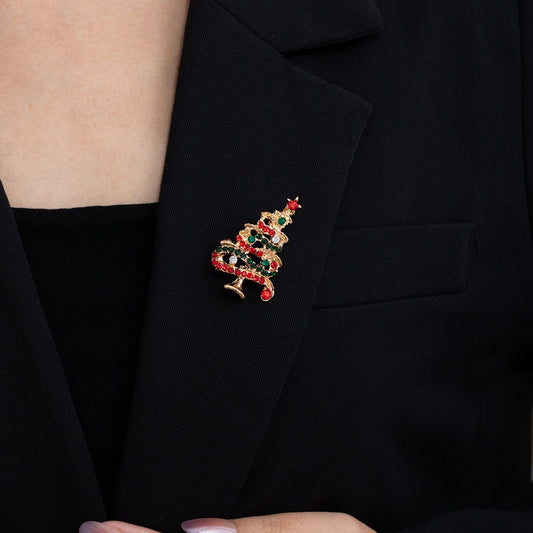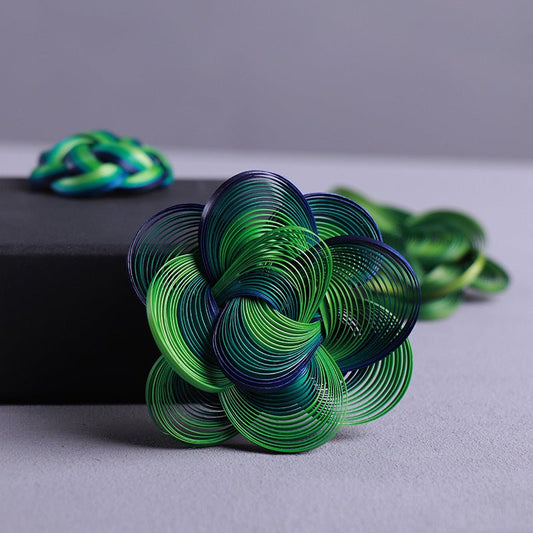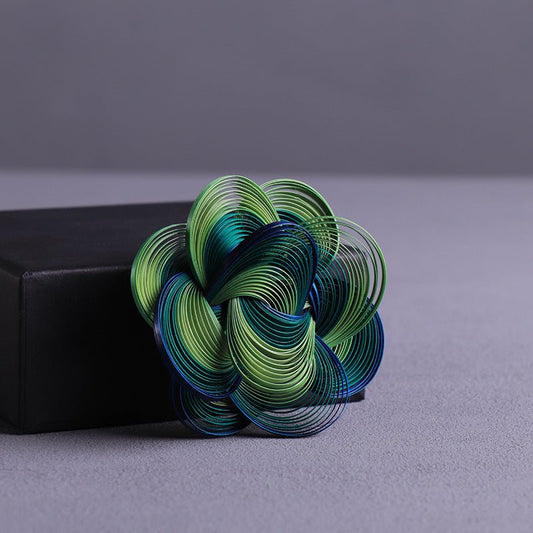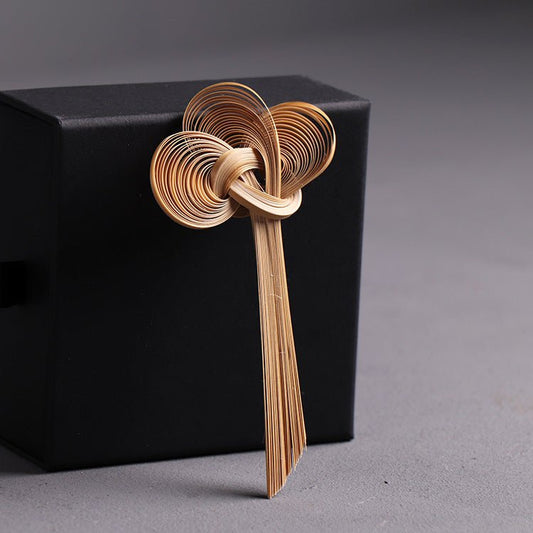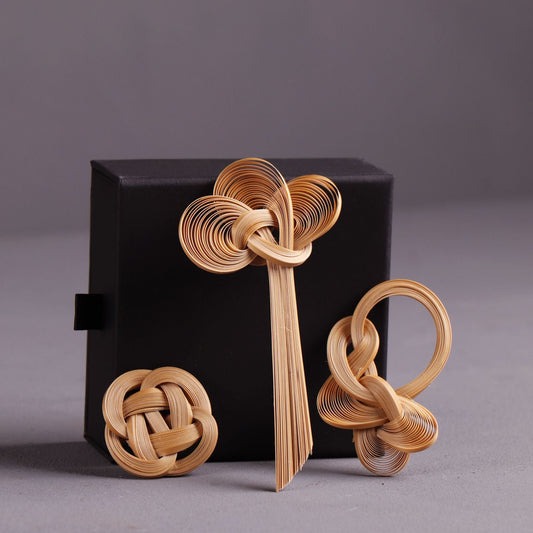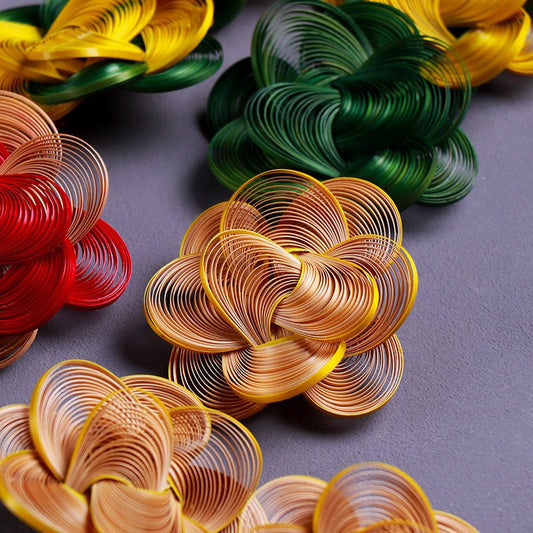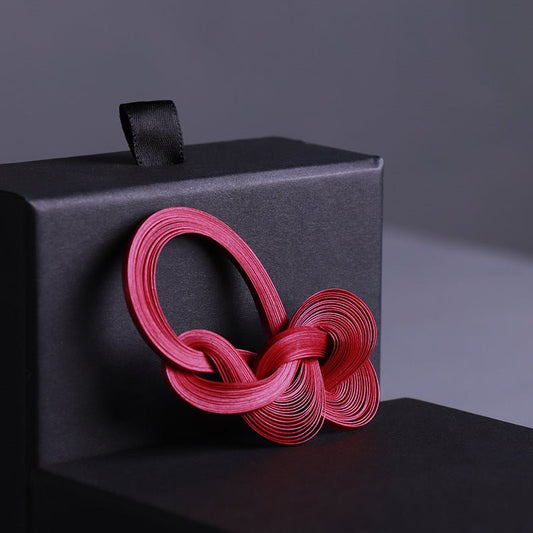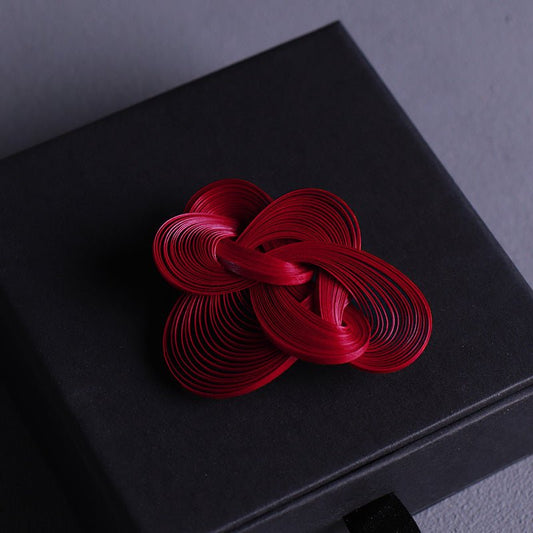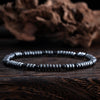-
Christmas Tree, Snowman & Apple Brooch Pins – Festive Jewelry with Rhinestones – Holiday Gifts for Women
Regular price $15.88save: 59% Sale price $15.88 Regular priceUnit price / per$38.88🎄 Celebrate the festive season in style with this adorable Christmas Tree, Snowman, and Apple Christmas Pin set! Perfect for adding a touch of sparkle to your holiday outfits, these pins are designed to bring joy and creativity to your winter wardrobe. Whether you're attending a holiday party, gathering with family, or looking for a gift, these festive brooches make an unforgettable statement.
✨ Design Features:
-
Christmas Tree Pin: Decorated with sparkling red and green rhinestones, it’s a perfect representation of the holiday spirit.
-
Snowman Pin: A cheerful snowman wearing a scarf, highlighted with shimmering rhinestones, making it an ideal festive accessory.
-
Apple Christmas Pin: Featuring a brilliant design with red rhinestones and a holiday ribbon, symbolizing peace and joy.
🎁 Versatile Gift: These charming holiday pins are great for gift exchanges, stocking stuffers, or a treat for yourself this season. Enhance your jacket, scarf, or sweater with these lovely pieces of Christmas jewelry.
💎 Benefits:
-
Adds instant holiday charm to any outfit.
-
High-quality rhinestone embellishments for maximum shine.
-
Lightweight and comfortable to wear all day.
-
Perfect for Christmas parties, festive gatherings, or as a holiday gift.
-
Durable and long-lasting design.
🛒 Get ready for the season of joy! These Christmas pins are a must-have addition to your festive wardrobe!
Product Parameters:
-
Material: High-quality rhinestones, metal.
-
Size: Christmas Tree (3.96cm x 2.53cm), Snowman (3.77cm x 2.62cm), Apple (4.40cm x 2.73cm).
-
Weight: Christmas Tree (7.4g), Snowman (10.6g), Apple (13.4g).
-
Color: Red, green, gold, white.
-
Closure: Secure pin back.
Precautions:
-
Store in a cool, dry place to avoid tarnishing.
-
Avoid direct contact with perfumes and lotions to preserve rhinestones.
-
Clean gently with a soft cloth to maintain shine.
-
Keep away from moisture.
Sale -
-
Handmade Bamboo Brooch & Accessories | Eco-Friendly Artisan Craft for Qipao & Hanfu
Regular price From $26.68save: 52% Sale price From $26.68 Regular priceUnit price / per$56.28🌿 Handmade Bamboo Accessories: Traditional Craft Meets Modern Elegance 🌿
Product Name:
Bamboo Handcrafted Brooch, , Hairpins, and Accessories Collection | Exquisite Bamboo Products for Qipao & Hanfu | Non-Heritage Artisan Craft 🌱
Product Description:
Elevate your fashion with our unique Bamboo Handcrafted Accessories, a blend of traditional craftsmanship and modern design. Each piece is meticulously handcrafted by skilled artisans, ensuring you wear a piece of heritage with every accessory. Whether you’re looking for a bamboo brooch, , or a beautiful hairpin, our collection offers you a stunning array of styles perfect for Qipao, Hanfu, or any occasion. 🌸✨
Made from premium bamboo that is both lightweight and durable, these accessories embody the elegance and beauty of nature. The vibrant green and blue hues of the bamboo showcase intricate weaving techniques, creating a luxurious yet environmentally-friendly fashion statement. 🌿🌱
Key Features:
-
Eco-Friendly Bamboo 🌍: 100% biodegradable and sustainable bamboo material, promoting a greener future.
-
Handmade Craftsmanship ✂️: Each item is carefully crafted by artisans, making every piece unique.
-
Elegant & Versatile 🎨: Perfect for enhancing your Qipao, Hanfu, or as a stylish addition to everyday wear.
-
Lightweight & Comfortable 💨: Bamboo is naturally lightweight, ensuring comfort even with extended wear.
-
Variety of Designs 🖼️: From floral brooches to butterfly-shaped , there’s something for every style.
Product Parameters:
-
Material: Bamboo
-
Color: Green, Blue, Natural Bamboo
-
Dimensions: Varies (Please check individual product size)
-
Packaging: Eco-friendly, recyclable packaging
How to Care for Your Bamboo Accessories:
-
Avoid Direct Sunlight ☀️: Prolonged exposure to sunlight may cause the bamboo to fade.
-
Store Properly 📦: Keep your accessories in a dry place to maintain their integrity and color.
-
Clean Gently 🧼: Use a soft cloth to wipe and clean the bamboo. Avoid harsh chemicals.
Why Choose Our Bamboo Accessories?
-
Timeless & Unique Design 🕰️: A perfect balance of heritage craftsmanship and modern aesthetic.
-
Perfect for Gifting 🎁: An ideal gift for fashion lovers, collectors, or anyone who appreciates artisan craftsmanship.
-
Versatile 🔄: Whether you wear traditional attire like Hanfu or modern fashion, these accessories add elegance to any look.
Important Notes:
-
Since this is a handcrafted product, there may be slight variations in color and design. Each piece is one-of-a-kind, making it a truly unique addition to your collection.
-
Free Worldwide Shipping 🚚 on orders over $50!
🌿 Ready to experience the charm of bamboo craftsmanship? Add a touch of nature to your wardrobe today! 🌿
Sale -
-
Handcrafted Bamboo Brooches, Pins & Accessories | Unique Artisan Bamboo Jewelry | Eco-Friendly Gifts for Qipao & Hanfu
Regular price $36.28save: 52% Sale price $36.28 Regular priceUnit price / per$76.28🌿 Elevate Your Look with Handcrafted Bamboo Accessories 🌿
Add an eco-conscious touch to your style with our collection of handmade bamboo accessories. Featuring bamboo brooches, pins, and earrings, these unique pieces are designed with traditional bamboo techniques. Whether you're wearing a Qipao, Hanfu, or just adding some creativity to your everyday attire, our bamboo jewelry stands out as a bold fashion statement that celebrates both nature and craftsmanship.
💎 Why Choose Bamboo?
Our bamboo accessories are made from sustainable bamboo, one of the most eco-friendly materials available. Not only is bamboo lightweight, but it’s also strong and durable, making it perfect for everyday wear. Plus, by choosing bamboo, you're supporting a greener future 🌍.✨ Artisan Craftsmanship at Its Finest
Each piece in our collection is meticulously handcrafted by skilled artisans. The intricate weaving and knotting techniques ensure that every bamboo brooch and pin is a unique work of art, perfect for adding an exclusive touch to your collection.Product Parameters:
-
Material: Premium eco-friendly bamboo
-
Color: Available in natural bamboo, red, yellow, green, and multi-colored options
-
Dimensions: Varies by design (please check individual product details)
-
Weight: Lightweight and comfortable for all-day wear
-
Care Instructions:
-
Avoid direct sunlight 🌞 to prevent color fading
-
Store in a dry place 🏠 to keep bamboo intact
-
Clean with a soft cloth 🧼, avoid harsh chemicals
-
Why You’ll Love Our Bamboo Accessories:
-
🌿 Sustainably Made: Each piece is crafted from renewable bamboo, making it an eco-friendly fashion choice.
-
✂️ Handcrafted Excellence: Our artisans use traditional methods to create intricate, unique designs that stand out.
-
💖 Versatile & Timeless: Perfect for Qipao, Hanfu, or modern casual wear, these accessories fit any occasion.
-
🎁 Ideal Gift: These beautifully crafted bamboo brooches and pins make a thoughtful gift for loved ones who appreciate traditional crafts and eco-conscious fashion.
-
💎 Unique & One-of-a-Kind: No two pieces are alike due to the handmade nature, making them truly special.
Important Notes:
-
Handmade Variations: As each piece is handmade, there may be slight variations in design and color, adding to its uniqueness.
-
Free Shipping 🚚: Enjoy free shipping on orders over $50 worldwide!
Sale -
-
Bamboo Craft Brooch & Accessories | Unique Artisan Bamboo Jewelry | Eco-Friendly Gifts
Regular price From $36.88save: 51% Sale price From $36.88 Regular priceUnit price / per$76.28Add a touch of natural elegance with our handcrafted bamboo accessories collection. Featuring a stunning array of bamboo brooches, earrings, hairpins, and pins, these unique accessories are perfect for Qipao, Hanfu, or any occasion where you want to express refined taste and eco-conscious style. Each piece is handmade by skilled artisans, blending traditional bamboo craftsmanship with modern design.
🌿 Sustainable & Eco-Friendly Bamboo:
Crafted from the finest bamboo, known for its lightweight and durable qualities, these accessories are environmentally friendly and sustainable. Bamboo is a fast-growing, renewable resource, making these accessories a perfect choice for eco-conscious fashionistas who value nature and sustainability. 🌱💎 Unique Artisan Craft:
Every piece is a one-of-a-kind masterpiece. The intricate bamboo weaving and delicate designs showcase traditional techniques passed down through generations of artisans, ensuring each accessory is a unique expression of craftsmanship.✨ Perfect for Every Occasion:
Whether you're wearing traditional Chinese attire like Qipao or Hanfu, or adding a touch of eco-chic flair to your daily wardrobe, these bamboo accessories elevate any outfit. Their timeless design also makes them the perfect gift for those who appreciate artisanal craftsmanship and eco-friendly fashion.
Product Parameters:-
Material: Premium eco-friendly Bamboo
-
Dimensions: Varies (check individual product for details)
-
Color: Available in vibrant natural tones like Green, Yellow, Red, and Earthy Beige
-
Weight: Lightweight design for everyday wear
-
Care Instructions:
-
Avoid direct sunlight ☀️: Prolonged exposure may cause fading
-
Store in a dry place 🏠: Ensure the bamboo stays in great shape
-
Gentle cleaning 🧼: Use a soft cloth to wipe off dust; avoid harsh chemicals.
-
Why Choose Our Bamboo Accessories?:-
🌍 Sustainability at Its Best: Made with eco-friendly, renewable bamboo that reduces environmental impact.
-
✂️ Handmade Craftsmanship: Each item is carefully crafted by skilled artisans, adding a personal touch to every accessory.
-
💖 Timeless Beauty: A perfect blend of traditional craftsmanship and modern design for fashion-forward individuals.
-
🎁 The Perfect Gift: Whether for a loved one or as a personal treat, these unique bamboo accessories make a thoughtful and meaningful gift.
Important Notes:
-
Due to the handcrafted nature of these accessories, each piece may have slight variations in color and design, making them truly unique.
-
Free shipping 🚚 is available for orders over $50! 🌍
Sale -
-
Handmade Bamboo Brooches & Accessories | Unique Bamboo Jewelry for Qipao, Hanfu & Fashion Lovers | Eco-Friendly Artisan Crafts
Regular price $36.28save: 52% Sale price $36.28 Regular priceUnit price / per$76.28✨ Discover the Beauty of Bamboo Craftsmanship ✨
Add an elegant touch to your look with our handmade bamboo accessories. From bamboo brooches and earrings to hairpins and pins, each piece is a beautiful representation of traditional Chinese craftsmanship. Meticulously handcrafted by artisans, these unique accessories combine eco-friendly materials with a modern twist. Perfect for those who love Qipao or Hanfu, these bamboo accessories bring timeless elegance to your wardrobe while honoring the heritage craftsmanship of bamboo.
🌱 Eco-Friendly Bamboo:
Made from sustainable bamboo, known for its strength, lightweight feel, and renewable properties. Our bamboo accessories are a green choice for the environmentally conscious fashion lover. 🌍💎 Artisan-Crafted Beauty:
Every piece is handmade with love and precision. The intricate weaving and knotting techniques ensure that each accessory is unique, making it a perfect piece to enhance your collection or to gift to someone special.Product Parameters:
-
Material: Premium bamboo
-
Color Options: Red, Beige, Natural Bamboo, and more
-
Dimensions: Varies by design (Check individual product sizes)
-
Packaging: Beautifully packaged in eco-friendly boxes
-
Weight: Lightweight for everyday comfort
-
Care Instructions:
-
Avoid direct sunlight ☀️ to prevent fading
-
Store in a dry place 🏠 to preserve the bamboo’s integrity
-
Clean gently 🧼 using a soft cloth to wipe off dust; avoid harsh cleaning products
-
Why Choose Our Bamboo Accessories?:
-
🌍 Sustainable: Made from eco-friendly bamboo, an environmentally friendly material.
-
✂️ Handmade Craftsmanship: Crafted by skilled artisans, each item is unique and designed with intricate weaving and knotting techniques.
-
💖 Versatile & Timeless: Whether you're pairing it with Qipao, Hanfu, or modern attire, these accessories add a distinctive touch to any outfit.
-
🎁 Perfect Gift: An ideal gift for birthdays, holidays, or any special occasion for someone who values artisan craftsmanship and eco-conscious fashion.
-
🌟 Exclusive Designs: Stand out with our collection of artisanal bamboo jewelry, perfect for those who appreciate unique, handcrafted beauty.
Important Notes:
-
Slight variations in design and color may occur due to the handcrafted nature of each piece, making them one-of-a-kind.
-
Free Shipping 🚚 available on orders over $50!
Sale -
Collection: Bamboo
How Bamboo Is Redefining Sustainability in Everyday Products 🌱
1. Introduction: Bamboo’s Role in Sustainable Living 🌍
In today’s world, sustainability is no longer just a buzzword; it’s an urgent necessity. As global environmental issues such as climate change 🌡️, deforestation 🌳, and plastic pollution 🗑️ continue to threaten our planet, the need for sustainable alternatives in everyday products is becoming increasingly important. People and industries alike are searching for solutions that are not only effective but also environmentally friendly and renewable. 🌱
One of the most promising solutions to this global challenge comes from nature itself — bamboo 🌾. Once considered a niche material, bamboo has rapidly gained popularity as a sustainable alternative to more traditional materials like wood, plastic, and cotton. Its fast growth, minimal resource requirements, and versatile uses make it an eco-friendly hero in the fight for a more sustainable future. 💚
From bamboo textiles 👗 to bamboo kitchenware 🍽️, this plant is now being used in a variety of products that contribute to green living and eco-conscious lifestyles. In this article, we will explore how bamboo is redefining sustainability, the environmental benefits it offers, and how its growing use in everyday products is helping to reduce environmental impact and promote a greener planet. 🌍
2. What Makes Bamboo Sustainable? 🌿
Bamboo is often hailed as one of the most sustainable materials available, and for good reason. Unlike many other resources, bamboo is renewable, low-impact, and highly efficient in its use of resources. Let’s dive into what makes bamboo such an environmentally friendly option.
Fast Growth and Regeneration 🌱
One of the most remarkable aspects of bamboo is its growth speed. Unlike trees, which can take decades to mature, bamboo can grow up to 1 meter per day, depending on the species. 🌱 This rapid growth cycle makes bamboo a highly renewable resource. After bamboo is harvested, it regenerates naturally from its existing root system, so there’s no need for replanting. 🌾
In contrast, traditional wood sources take many years to grow and require significant land clearing, which can lead to deforestation 🌳. Bamboo, on the other hand, can be grown sustainably with minimal land disturbance, making it a better alternative to hardwoods. It’s a plant that grows back quickly without replanting, making it self-sustaining and easy to harvest year after year. 🌿
Minimal Water Usage 💧
Another significant advantage of bamboo is its low water consumption. Traditional crops like cotton require enormous amounts of water to grow, leading to water shortages in many regions of the world. 🌍 Bamboo, however, thrives in a variety of climates and requires significantly less water to grow compared to many other crops. This makes bamboo an ideal choice for sustainable agriculture, particularly in areas where water is a scarce resource. 💦
Bamboo’s ability to grow with minimal water resources means that it can be cultivated without stressing local water supplies, making it a water-efficient crop 🌾. This is particularly beneficial in areas that experience drought or where traditional water-intensive crops have been unsustainable.
Carbon Sequestration 🌍
Bamboo also stands out for its carbon sequestration abilities. It absorbs more carbon dioxide than many trees and other plants, making it an essential part of any effort to combat climate change 🌡️. Bamboo’s ability to absorb up to 35% more CO2 than trees during its growing period means it plays a crucial role in reducing greenhouse gases in the atmosphere. 🌱
As a plant that is naturally efficient at carbon absorption, bamboo helps to mitigate the effects of climate change by removing excess CO2 from the air. 🌿 Bamboo forests can be seen as powerful carbon sinks, helping to lower atmospheric carbon levels, reduce global warming, and promote healthier ecosystems. 🌍
3. Bamboo in Everyday Products 🏠
Bamboo’s unique characteristics make it an incredibly versatile material, one that can be used in a wide range of products in everyday life. Whether in your wardrobe, your kitchen, or your bathroom, bamboo is showing up in more and more items that are making eco-conscious living easier. 🌱
Bamboo Textiles for Eco-Conscious Fashion 👗
Bamboo-based textiles are quickly becoming a popular choice for those who want to make their fashion choices more sustainable. Bamboo fabric is made from the pulp of the bamboo plant and is known for being soft, breathable, and naturally antibacterial. It is also hypoallergenic, making it a great option for those with sensitive skin. 🌿
Unlike cotton, which requires large amounts of water and pesticides, bamboo grows with little need for synthetic fertilizers or pesticides. This makes bamboo-based textiles a more environmentally friendly choice. 🌾 In addition, bamboo fabric is biodegradable, which means it breaks down naturally at the end of its life cycle, unlike synthetic fabrics that can persist in landfills for years.
Bamboo clothing is not only comfortable and soft to the touch, but it is also eco-friendly and durable. Whether it’s a pair of bamboo socks, a T-shirt, or even bamboo bedding, this material is becoming a preferred choice for those seeking to reduce their environmental footprint while enjoying high-quality fabrics. 👚
Bamboo Kitchenware 🍽️
In the kitchen, bamboo has proven to be an excellent alternative to plastic and wood. Bamboo is incredibly durable, and its natural properties make it antibacterial and resistant to moisture, making it ideal for products like cutting boards, utensils, and kitchen storage solutions. 🥢
Not only is bamboo strong and versatile, but it is also lightweight and affordable compared to other materials, making it an attractive option for eco-conscious consumers. Additionally, bamboo products are biodegradable, so when they reach the end of their lifespan, they won’t sit in a landfill for years. 🌱
Bamboo Furniture and Home Décor 🏡
Bamboo has also made its way into furniture and home décor, offering a stylish and sustainable alternative to traditional materials like hardwood. Bamboo furniture is known for its strength, lightness, and versatility. It can be used to make everything from chairs and tables to shelves and beds. 🌾
Bamboo’s natural aesthetic also makes it a great material for home décor items like lampshades, picture frames, and wall art. Whether you’re looking for sleek, modern designs or rustic charm, bamboo offers a variety of options to fit your home’s décor. 🌿
Personal Care Products 🚿
In the world of personal care, bamboo has become a go-to material for a range of products, including toothbrushes, combs, shavers, and bath brushes. Bamboo toothbrushes, in particular, have become an extremely popular eco-friendly alternative to plastic toothbrushes. 🪥
The handles of these brushes are made from bamboo, and they are biodegradable, unlike plastic toothbrushes that can take hundreds of years to break down. 🌍 Bamboo is naturally antimicrobial, which makes it a great choice for hygiene products. Additionally, other bamboo-based personal care items, such as hairbrushes, razors, and soap dishes, are gaining popularity as more people look for ways to reduce their plastic consumption. 🌱
4. The Environmental Impact of Bamboo 🌍
Bamboo’s benefits go beyond just being a renewable resource. Its environmental impact is one of the key reasons why it is considered one of the most sustainable materials in the world today. 🌎
Low Environmental Footprint 🌿
Compared to other materials like wood or plastic, bamboo has a minimal environmental footprint. Bamboo grows quickly, requires little water, and doesn’t need fertilizers or pesticides. 🌱 Bamboo farming also helps reduce soil erosion and promotes biodiversity in the areas where it is cultivated. 🌾
By replacing traditional materials with bamboo, we can help reduce deforestation and pollution while supporting sustainable agricultural practices. Bamboo farming also provides jobs for local communities, making it an economically beneficial and socially responsible choice.
Recycling and Biodegradability ♻️
Bamboo is fully biodegradable, meaning it won’t pollute the environment once it reaches the end of its life cycle. In fact, bamboo can be composted, making it a great choice for reducing landfill waste. 🌿 Unlike plastic, which takes hundreds of years to decompose, bamboo products break down quickly and naturally, leaving no harmful toxins behind. 🌍
Bamboo is also recyclable, meaning its fibers can be repurposed and used to create new products. This ability to recycle and biodegrade is a key part of the circular economy, where materials are used in a way that reduces waste and maximizes resource use.
Here is the second part of the article on "How Bamboo Is Redefining Sustainability in Everyday Products 🌱," continuing from where we left off.
5. Bamboo vs. Traditional Materials 🌱
Bamboo offers a sustainable alternative to many traditional materials that have long been associated with environmental harm. Let’s compare bamboo with commonly used materials like wood, plastic, and cotton, to understand why it’s becoming a preferred choice for environmentally conscious consumers. 🌍
Bamboo vs. Wood 🌳
Wood has been a staple material in construction, furniture, and paper for centuries. However, the sustainability of wood depends on the type of tree and the harvesting practices. Many hardwoods take decades to mature, and the process of cutting down trees can lead to deforestation 🌳, which significantly harms biodiversity and contributes to climate change.
In contrast, bamboo grows at an incredible rate, reaching maturity in just 3-5 years, compared to the decades it takes for hardwood trees to mature. 🌿 Bamboo can also be harvested without the need for replanting, as it naturally regenerates. This makes bamboo a more sustainable choice than wood, as it reduces pressure on forests and allows for continuous cultivation. 🌱
Bamboo vs. Plastic ♻️
Plastic pollution is one of the most pressing environmental issues today, with millions of tons of plastic ending up in landfills and oceans every year. 🌊 While plastic is durable and cheap, it is also non-biodegradable and takes centuries to decompose.
Bamboo, on the other hand, is fully biodegradable and compostable, meaning it breaks down naturally over time, causing no long-term harm to the environment. 🌱 Bamboo products, such as straws, toothbrushes, and packaging, are rapidly replacing single-use plastics and reducing plastic waste. 🌍 By choosing bamboo over plastic, we can significantly cut down on pollution and make a real difference in the fight against plastic waste. 🚯
Bamboo vs. Cotton 🌾
Cotton is often considered a natural and eco-friendly material, but its environmental footprint is considerable. Cotton requires large amounts of water, pesticides, and fertilizers to grow, and it takes up a lot of land space. In fact, cotton farming is responsible for a significant portion of global pesticide use. 🚜
Bamboo, in contrast, requires very little water, no chemical fertilizers or pesticides, and grows in a variety of climates. 🌱 This makes bamboo a far more sustainable and eco-friendly choice compared to cotton. Bamboo fabric is also naturally antibacterial and hypoallergenic, making it a great option for clothing and bedding. 🛏️
6. Benefits of Bamboo-Based Products 🌍
Bamboo-based products offer a wide range of benefits that make them a popular choice for consumers who want to make sustainable living easier and more affordable. Let’s explore some of the key advantages of using bamboo in everyday items.
Durability and Strength 💪
Bamboo is an incredibly strong and durable material. Bamboo is stronger than many hardwoods and is resistant to wear and tear, making it ideal for a variety of products. From furniture and flooring to kitchenware, bamboo products are long-lasting and tough. 🌿
Bamboo’s durability is one of the reasons it is so widely used in high-traffic areas and heavy-duty applications. Bamboo flooring, for example, can withstand the daily wear of a household while maintaining its beauty and integrity for years. 🌱
Aesthetic Appeal 🌾
Bamboo is not just practical but also beautiful. Its light, natural appearance adds a touch of elegance and serenity to any space. Whether you’re looking for minimalistic furniture, a modern bamboo chair, or stylish home accessories, bamboo’s clean lines and neutral color make it a perfect fit for almost any décor. 🌍
Its aesthetic appeal is one of the reasons bamboo is so widely used in interior design and furniture. The lightness and texture of bamboo add a fresh, airy feel to rooms, making it a popular choice for eco-conscious consumers. 🌱
Affordable and Accessible 💸
Despite its durability and stylish appearance, bamboo is also cost-effective. Compared to other sustainable materials like hardwood or even some synthetic options, bamboo products tend to be more affordable and widely available. This makes it easier for consumers to switch to bamboo alternatives without breaking the bank. 💵
The affordability of bamboo means that it is accessible to a wide range of people, from budget-conscious consumers to those seeking more luxurious eco-friendly options. Whether it’s a bamboo toothbrush or bamboo furniture, this material is helping to make sustainability accessible to everyone. 🌱
7. How to Incorporate Bamboo Products into Your Life 🌍
Making the switch to bamboo-based products is an easy and effective way to reduce your environmental footprint. Whether you’re updating your home, wardrobe, or daily routines, here are a few simple ways you can incorporate bamboo into your life.
Bamboo in the Home 🏡
From bamboo flooring to bamboo furniture, incorporating bamboo into your home is an excellent way to live more sustainably. Bamboo furniture is lightweight, strong, and stylish, and it comes in a variety of styles that can fit any home décor. 🛋️ Whether you're looking for modern bamboo chairs or a sleek bamboo coffee table, these products bring an elegant and sustainable touch to your living space.
Bamboo flooring is also an attractive option for those looking for a sustainable flooring solution. It is durable, easy to clean, and adds a natural, light touch to any room. 🌾
Sustainable Bamboo Fashion 👗
Switching to bamboo fabrics for clothing, bedding, and towels is an easy way to embrace eco-friendly fashion. Bamboo fabric is soft, breathable, and naturally antibacterial, making it an excellent alternative to synthetic materials. 🌱 Bamboo clothing is comfortable, stylish, and most importantly, environmentally friendly.
Consider replacing traditional cotton T-shirts, sheets, and towels with bamboo alternatives to reduce water consumption and promote a sustainable lifestyle. 👚 Bamboo clothing is now widely available, and it is becoming easier to find stylish options for any occasion.
Eco-Friendly Bamboo Packaging 📦
Another way to reduce your environmental impact is by choosing bamboo-based packaging over plastic. Many companies are now using bamboo packaging for food products, cosmetics, and consumer goods. 🌿 Bamboo packaging is not only biodegradable but also reduces the need for harmful plastic materials. When shopping for products, look for those packaged in sustainable bamboo containers or boxes. 🌍
8. The Future of Bamboo in Sustainability 🌿
As global demand for sustainable products continues to rise, the future of bamboo in sustainability looks very bright. Innovative uses for bamboo are constantly emerging, and it is quickly becoming a central material in a range of green technologies.
Innovative Bamboo Products 🔬
One exciting area for the future of bamboo is in the development of biodegradable plastics. Researchers are working on creating bamboo-based bioplastics that can replace traditional plastic in various applications. These bioplastics are compostable, non-toxic, and made from a renewable resource, making them an excellent alternative to petroleum-based plastics. 🌱
Additionally, bamboo is being used to create advanced building materials such as bamboo composites for construction, which are both strong and sustainable. These materials have the potential to transform the construction industry by offering a low-carbon alternative to traditional building materials like concrete and steel. 🏗️
Global Bamboo Adoption 🌍
Bamboo’s growing popularity is not just a trend; it is a global movement toward a more sustainable future. Countries around the world are recognizing bamboo’s potential, and it is becoming an essential part of efforts to reduce environmental impact and promote eco-friendly living. 🌎 As industries continue to explore new and innovative uses for bamboo, it is likely that we will see it play an even bigger role in sustainable production and consumption in the years to come.
Conclusion: Bamboo’s Role in a Sustainable Future 🌱
Bamboo is truly a game-changer in the quest for sustainability. Its versatility, renewability, and low environmental impact make it one of the most sustainable materials available today. From fashion to home décor to personal care, bamboo is redefining how we think about eco-friendly alternatives.
As the world continues to look for solutions to environmental challenges, bamboo is leading the way toward a greener, more sustainable future. 🌿 It’s not just about adopting bamboo products but also about creating a lifestyle that embraces sustainability, reduces waste, and supports renewable resources.
Start making the switch today by choosing bamboo-based products and join the global movement toward a more sustainable world. 🌍
Bamboo’s growing presence in everyday products like textiles, kitchenware, furniture, and personal care items highlights its potential to redefine sustainability in the modern world. 🌍 It’s a material that is renewable, eco-friendly, and versatile, making it an attractive choice for those looking to live a more sustainable lifestyle.










